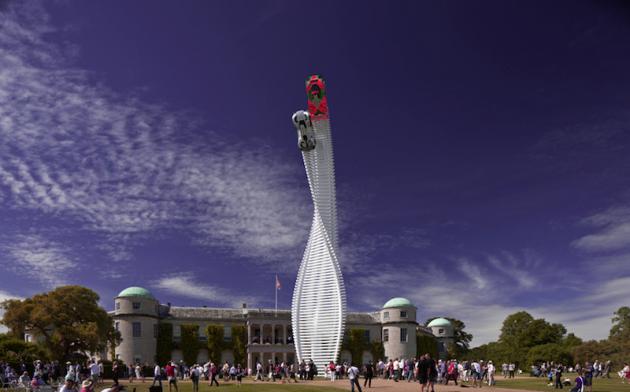Gerry Judah’s the artist known for his relief sculptures of war torn zones and freestanding Indian shrines has again created the centrepiece at the 2015 Goodwood Festival of Speed, which this year celebrates the Mazda Motor Corporation’s unique motorsport heritage with a powerful fusion of sculptural innovation and engineering precision.
Locked in close contention, the rotary-engined 787B Le Mans winner and the LM55 Vision Gran Turismo concept sprint 40 metres skywards trailing a spectacular slipstream of muscular twisted steel.

Stacked in the manner of pristine matchsticks, 720 steel beams of varying length and juxtaposition seamlessly swell, slim and fold the structure from right to left, cantilevering the cars high over the spectators below.
Featuring 120 tonnes of steel sections which, laid end-to-end, would stretch the entire 1235 metre length of the Goodwood Hill Climb, this beguiling structure is sculptor Gerry Judah’s most complex and sophisticated Centrepiece to date.

Born in 1951 in Calcutta, India, Gerry Judah moved to London with his family at the age of ten years old. A graduate of Goldsmiths College and Slade School of Fine Art, Judah has worked on settings for some of the UK’s leading theatres, museums and public spaces, including the Royal Opera House, Royal Shakespeare Company, British Museum, English National Opera and Royal Ballet. In 2000, the Imperial War Museum commissioned Judah to create a large-scale model of the selection ramp in Auschwitz- Birkenau for the Holocaust Exhibition, opened by Queen Elizabeth II. The project signalled a shift in the thematics of Judah’s work towards art borne of his reflections on political, historical and environmental issues, culminating in collaborations with organisations including Christian Aid and the British High Commission, India.
Gerry Judah’s work has been exhibited at Whitechapel Gallery, Camden Arts Centre and Yorkshire Sculpture Park, St. Paul’s Cathedral and has entered many international public and private collections including the Saatchi Collection London, and the Imperial War Museum.

